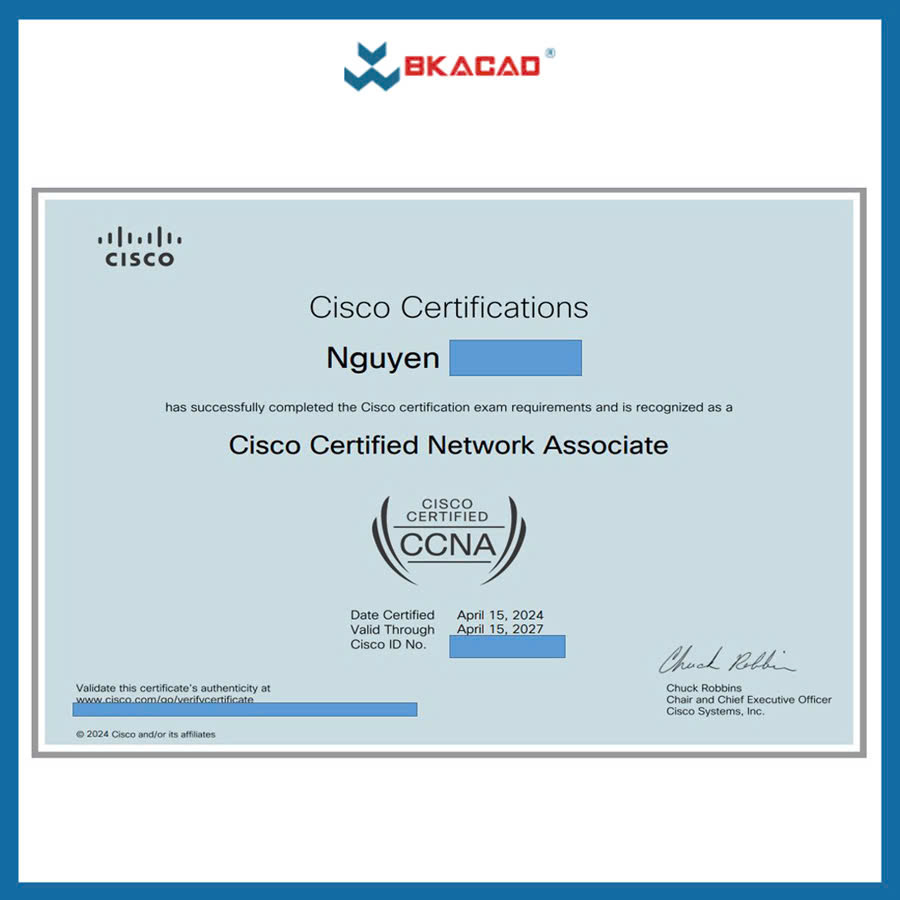Tin tức
HƯỚNG DẪN BÀI THI CHỨNG CHỈ QUỐC TẾ CCNA 200-301 V1.1 HIỆU LỰC TỪ 20/8/2024
HƯỚNG DẪN BÀI THI CHỨNG CHỈ QUỐC TẾ CCNA 200-301 V1.1 HIỆU LỰC TỪ 20/8/2024
Kỳ thi CCNA 200-301 v1.1 bắt đầu được áp dụng từ 20/8/2024. Các chủ đề mới trong kỳ thi bao gồm Trí tuệ nhân tạo, Quản lý mạng đám mây và Học máy. Những cập nhật này chiếm chưa đến 10% tổng nội dung kỳ thi. Để xem các bản cập nhật nhỏ mới nhất cho CCNA v1.1, hãy xem lại các chủ đề của kỳ thi.

1. Thời gian: 120 phút
2. Giá thi chứng chỉ Quốc tế: 300$
3. Voucher giảm giá của hãng: 58%
4. Ngôn ngữ: Tiếng Anh, Tiếng Nhật
5. Số lượng câu hỏi: 120 câu hỏi và yêu cầu hiểu biết sâu sắc về các khái niệm mạng và thực hành thực tế. Bạn cần đạt ít nhất 825/1000 điểm
6. Tóm tắt các chủ đề trong bài thi CCNA 200-301
1.0. Network Fundamentals (20%)
1.1 Explain the role and function of network components
1.1.a Routers
1.1.b Layer 2 and Layer 3 switches
1.1.c Next-generation firewalls and IPS
1.1.d Access points
1.1.e Controllers (Cisco DNA Center and WLC)
1.1.f Endpoints
1.1.g Servers
1.1.h PoE
1.2 Describe characteristics of network topology architectures
1.2.a Two-tier
1.2.b Three-tier
1.2.c Spine-leaf
1.2.d WAN
1.2.e Small office/home office (SOHO)
1.2.f On-premise and cloud
1.3 Compare physical interface and cabling types
1.3.a Single-mode fiber, multimode fiber, copper
1.3.b Connections (Ethernet shared media and point-to-point)
1.4 Identify interface and cable issues (collisions, errors, mismatch duplex, and/or speed)
1.5 Compare TCP to UDP
1.6 Configure and verify IPv4 addressing and subnetting
1.7 Describe private IPv4 addressing
1.8 Configure and verify IPv6 addressing and prefix
1.9 Describe IPv6 address types
1.9.a Unicast (global, unique local, and link local)
1.9.b Anycast
1.9.c Multicast
1.9.d Modified EUI 64
1.10 Verify IP parameters for Client OS (Windows, Mac OS, Linux)
1.11 Describe wireless principles
1.11.a Nonoverlapping Wi-Fi channels
1.11.b SSID
1.11.c RF
1.11.d Encryption
1.12 Explain virtualization fundamentals (server virtualization, containers, and VRFs)
1.13 Describe switching concepts
1.13.a MAC learning and aging
1.13.b Frame switching
1.13.c Frame flooding
1.13.d MAC address table
2.0 Network Access (20%)
2.1 Configure and verify VLANs (normal range) spanning multiple switches
2.1.a Access ports (data and voice)
2.1.b Default VLAN
2.1.c InterVLAN connectivity
2.2 Configure and verify interswitch connectivity
2.2.a Trunk ports
2.2.b 802.1Q
2.2.c Native VLAN
2.3 Configure and verify Layer 2 discovery protocols (Cisco Discovery Protocol and LLDP)
2.4 Configure and verify (Layer 2/Layer 3) EtherChannel (LACP)
2.5 Interpret basic operations of Rapid PVST+ Spanning Tree Protocol
2.5.a Root port, root bridge (primary/secondary), and other port names
2.5.b Port states (forwarding/blocking)
2.5.c PortFast
2.5.d Root guard, loop guard, BPDU filter, and BPDU guard
2.6 Describe Cisco Wireless Architectures and AP modes
2.7 Describe physical infrastructure connections of WLAN components (AP, WLC, access/trunk ports, and LAG)
2.8 Describe network device management access (Telnet, SSH, HTTP, HTTPS, console, TACACS+/RADIUS, and cloud managed)
2.9 Interpret the wireless LAN GUI configuration for client connectivity, such as WLAN creation, security settings, QoS profiles, and advanced settings
3.0. IP Connectivity (25%)
3.1 Interpret the components of routing table
3.1.a Routing protocol code
3.1.b Prefix
3.1.c Network mask
3.1.d Next hop
3.1.e Administrative distance
3.1.f Metric
3.1.g Gateway of last resort
3.2 Determine how a router makes a forwarding decision by default
3.2.a Longest prefix match
3.2.b Administrative distance
3.2.c Routing protocol metric
3.3 Configure and verify IPv4 and IPv6 static routing
3.3.a Default route
3.3.b Network route
3.3.c Host route
3.3.d Floating static
3.4 Configure and verify single area OSPFv2
3.4.a Neighbor adjacencies
3.4.b Point-to-point
3.4.c Broadcast (DR/BDR selection)
3.4.d Router ID
3.5 Describe the purpose, functions, and concepts of first hop redundancy protocols
4.0. IP Services (10%)
4.1 Configure and verify inside source NAT using static and pools
4.2 Configure and verify NTP operating in a client and server mode
4.3 Explain the role of DHCP and DNS within the network
4.4 Explain the function of SNMP in network operations
4.5 Describe the use of syslog features including facilities and levels
4.6 Configure and verify DHCP client and relay
4.7 Explain the forwarding per-hop behavior (PHB) for QoS, such as classification, marking, queuing, congestion, policing, and shaping
4.8 Configure network devices for remote access using SSH
4.9 Describe the capabilities and functions of TFTP/FTP in the network
5.0. Sercurity Fundamentals (15%)
5.1 Define key security concepts (threats, vulnerabilities, exploits, and mitigation techniques)
5.2 Describe security program elements (user awareness, training, and physical access control)
5.3 Configure and verify device access control using local passwords
5.4 Describe security password policies elements, such as management, complexity, and password alternatives (multifactor authentication, certificates, and biometrics)
5.5. Describe IPsec remote access and site-to-site VPNs
5.6 Configure and verify access control lists
5.7 Configure and verify Layer 2 security features (DHCP snooping, dynamic ARP inspection, and port security)
5.8 Compare authentication, authorization, and accounting concepts
5.9 Describe wireless security protocols (WPA, WPA2, and WPA3)
5.10 Configure and verify WLAN within the GUI using WPA2 PSK
6.0. Automation and Programmability (10%)
6.1 Explain how automation impacts network management
6.2 Compare traditional networks with controller-based networking
6.3 Describe controller-based, software defined architecture (overlay, underlay, and fabric)
6.3.a Separation of control plane and data plane
6.3.b Northbound and Southbound APIs
6.4 Explain AI (generative and predictive) and machine learning in network operations
6.5 Describe characteristics of REST-based APIs (authentication types, CRUD, HTTP verbs, and data encoding)
6.6 Recognize the capabilities of configuration management mechanisms, such as Ansible and Terraform
6.7 Recognize components of JSON-encoded data
7. Một số phần kiến thức không nên bỏ qua:
- Các kỳ thi thực hành: Các bài kiểm tra này ngoài việc đánh giá kiến thức đã học được của bạn, còn giúp các thí sinh hiểu được định dạng câu hỏi và quản lý thời gian trong các kỳ thi thực tế.
- Kiến thức Tự động hóa: Tự động hóa ngày càng trở nên quan trọng trong mạng lưới và nhiều ứng viên bỏ qua phần này. Hãy đảm bảo bạn dành đủ thời gian để hiểu các khái niệm tự động hóa và cách chúng áp dụng vào mạng lưới.
- Kiến thức IPv6: IPv6 là một phần cơ bản của kỳ thi CCNA.Bạn cần hiểu rõ về địa chỉ IPv6, cấu hình và định tuyến.
Chứng chỉ CCNA vẫn luôn là những yếu tố cần thiết để bạn thúc đẩy sự phát triển nghề nghiệp
Bằng cách hiểu rõ các chủ đề của kỳ thi, lập kế hoạch học tập vững chắc và sử dụng đúng nguồn lực, bạn sẽ tiến gần đến thành công.
Tham khảo chương trình đào tạo chuẩn hãng khóa học CCNA tại: https://bkacad.edu.vn/cac-khoa-hoc-quan-tri-mang-quoc-te-cco36.html



